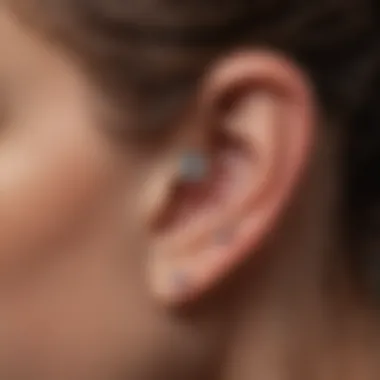Understanding the Tragus: Anatomy and Clinical Insights


Intro
The tragus is a relatively small component of the outer ear, yet it plays a multilayered role in both biological and aesthetic contexts. Often overlooked by both students and professionals, a deep understanding of its anatomy and function reveals its significance in various medical fields and cosmetic practices. This section introduces the foundational aspects of the tragus, including its physical characteristics, physiological roles, and potential implications in clinical settings.
Diving into these details enhances our comprehension of the tragus, not just as a distinct structure but as an essential element influencing auditory health and aesthetic procedures. Studying the tragus can spark interest in its complex interactions within the larger framework of human anatomy and its relevance in contemporary healthcare.
Key Findings
Major Results
The examination of the tragus yields several important insights:
- The tragus aids in the funneling of sound waves into the ear canal, crucial for effective hearing.
- Its prominence and shape can significantly affect both the function and styling in cosmetic ear procedures.
- The tragus serves as a point of intervention in medical examinations for ear-related issues.
Research highlights how the tragus's structural features contribute to its multifaceted role in hearing and aesthetics. Its standout feature is that it often varies in size and shape among individuals, which can impact both auditory function and design considerations in cosmetic surgery.
Discussion of Findings
Understanding these findings elucidates the tragus's importance. The physiological role in auditory perception underscores why medical practitioners should include it in assessments related to hearing loss or ear conditions. Additionally, its presence in cosmetic surgery, particularly in procedures like otoplasty, places it at the center of discussions about the balance between form and functionality.
"The tragus is more than a mere anatomical structure; it represents a bridge between aesthetics and health, profoundly influencing both one’s appearance and auditory abilities."
Methodology
Research Design
This investigation into the tragus utilizes a qualitative approach, focusing on literature reviews and clinical studies to synthesize existing knowledge. By examining various sources, the study aims to present a robust view of the tragus's significance.
Data Collection Methods
Data was gathered from academic journals, health databases, and clinical research reports. Resources such as Wikipedia and Britannica provided foundational knowledge. Interviews with healthcare professionals further enriched the understanding of the tragus's clinical relevance, enabling a deeper discussion into its anatomy and functions.
Anatomy of the Tragus
The anatomy of the tragus is central to understanding the functional aspects of the ear as well as its clinical relevance. The tragus is a small, cartilaginous projection located on the outer ear. It serves various roles in sound localization, protection of the ear canal, and has implications in both audiology and cosmetic surgery. Therefore, a detailed examination of its anatomical features is paramount.
Location and Structure
The tragus is situated in front of the ear canal, forming a prominent feature of the outer ear. Its anatomical structure consists of elastic cartilage covered by skin, which allows for some flexibility. The size and shape of the tragus can vary substantially among individuals, contributing to its diversity in function. Its positioning near the external auditory meatus plays a role in directing sound waves into the ear canal. Understanding the specific structure of the tragus helps medical professionals assess its role in various conditions affecting hearing and ear health.
Surrounding Ear Anatomy
To appreciate the significance of the tragus, one must also consider its surrounding anatomy. The tragus is part of the larger auricle, which includes structures like the antihelix, concha, and lobule. Each of these components contributes to the overall function of the ear. For instance, the concha leads directly into the ear canal, facilitating sound wave transmission. The antihelix offers additional support and definition to the ear’s shape. Together, these features enhance the ear’s ability to capture and channel sound.
Variations in Tragus Size and Shape


Variations in tragus size and shape can have clinical implications. Some individuals have a larger tragus, while others might have a more diminutive or differently shaped one. These differences can influence how sound is localized and might affect audiological assessments. Additionally, cosmetic preferences lead some people to modify their tragus through piercings or surgical alterations. This variety illustrates the tragus's importance not only from a medical standpoint but also in terms of personal expression and culture.
Functions of the Tragus
The tragus plays several critical roles in the human auditory system. Understanding these functions can shed light on its importance from both a biological and clinical perspective. The tragus is not merely an anatomical structure; it has significant implications for sound processing, ear protection, and auditory experiences.
Sound Localization
One primary function of the tragus is sound localization. This ear structure helps in determining the direction of sounds reaching the ear. When a sound originates from the side of the head, it hits the ear at slightly different times and intensities. The tragus contributes to this by providing an acoustic shadow, enabling the brain to perceive where the sound comes from more accurately.
Research suggests that these minor variations are crucial for distinguishing the source of sounds, especially in complex environments. The tragus, while small, plays a significant part in how effectively we can hear and react to our surroundings.
Protective Role in the Ear
Another notable function is the protective role of the tragus. It acts as a barrier, guarding the ear canal against foreign bodies and environmental hazards. The tragus's position and rigid structure help shield the ear from dust, debris, and water. This feature is particularly important during activities such as swimming or in windy conditions.
In addition to blocking physical barriers, the tragus may assist in regulating airflow and reducing pressure changes in the ear canal. This function can help preserve the delicate structures within the ear, thereby supporting overall auditory health.
Impact on Auditory Perception
The impact of the tragus on auditory perception cannot be overstated. Its shape influences how sound waves enter the ear canal, affecting the auditory signals processed by the brain. Individuals with variations in tragus size or shape may experience slight differences in their auditory perception. For instance, a flared tragus may enhance certain frequencies, while a more pronounced tragus could dampen them.
Understanding these effects is essential, especially in clinical settings where auditory evaluations are necessary. Audiologists consider the tragus's structure when assessing hearing capabilities and designing personalized auditory solutions.
In summary, the tragus serves essential functions in sound localization, offers protection to the ear, and significantly influences auditory perception. These roles highlight the tragus's profound impact on hearing and its clinical relevance in healthcare.
Tragus in Cosmetology
The tragus, although a small part of the ear, holds considerable importance in the realm of cosmetology. This anatomical structure is often the center of various beauty trends and has undergone significant cultural evolution over time. The aesthetic appeal of the tragus has made it a focal point for certain forms of body modification, leading to a rise in both popularity and acceptance of tragus piercings. Understanding the trends and implications surrounding these practices offers deeper insights into societal values and personal expression.
Piercing Trends and Cultural Significance
Piercing the tragus has become increasingly popular across different demographics. Initially viewed as an alternative form of self-expression, tragus piercings are now considered a fashion statement. Many individuals view them as a way to enhance their personal style.
The cultural significance of tragus piercings varies by region and community. In some cultures, piercings hold traditional value, symbolizing rites of passage or membership in particular groups. For example, certain Indigenous cultures have a rich history of ear adornments that extend beyond simple aesthetics.
- Fashion Influence: Influencers and celebrities often lead trends, encouraging their followers to adopt similar styles.
- Diversity of Jewelry: With a variety of materials and styles, from simple studs to intricate hoops, the tragus piercing has options for anyone's taste.
Surgical Alterations
In the cosmetic surgery field, the tragus can be altered for both aesthetic and practical reasons.
Some procedures involve reshaping the tragus to enhance overall ear symmetry or improve facial balance. These changes can significantly impact a person’s appearance, often resulting in enhanced self-esteem and satisfaction.
Surgical interventions may include:


- Reduction or Augmentation: In some cases, patients seek to reduce the size of the tragus or augment it for better proportions with the ears.
- Corrective Surgery: For those with congenital deformities, surgical alterations serve a functional role.
Psychological Impacts of Piercings
The psychological effects of tragus piercings can be profound, influencing self-perception and social identity. Engaging in body modification can lead to a sense of empowerment for many individuals. People may feel that piercings represent their rebellion against societal norms or serve as symbols of individuality.
"Body modifications, including piercings, can be a pathway for self-expression and can create a deeper connection to one’s identity."
Some potential psychological impacts include:
- Increased Confidence: Many individuals report feeling more confident after getting a tragus piercing.
- Social Connection: Sharing the experience of piercings can foster connections among peers, strengthening communal bonds.
- Body Image Reflection: The choice to pierce can be both a response to and a reflection of a person's body image and feelings towards their self.
In summary, the tragus occupies a unique position in cosmetology, intersecting fashion, culture, and psychology. Its relevance stretches further than aesthetic appeal; it embodies personal narratives and cultural stories. Recognizing these aspects can provide further understanding of how body modification practices are embraced in contemporary society.
Clinical Relevance of the Tragus
The tragus holds notable significance in various clinical settings. Its unique anatomical and physiological attributes contribute to understanding numerous ear-related conditions. This section aims to unravel how the tragus plays a role in ear infections, audiology, and pain management. The information presented serves students, researchers, and health professionals, illustrating the tragus's multifaceted importance in both health and aesthetics.
Tragus and Ear Infections
Ear infections, notably otitis externa, can often affect the tragus. The proximity of this structure to the ear canal makes it an essential area to understand when diagnosing and treating ear infections. Inflammatory responses may cause swelling or tenderness in the tragus. Healthcare providers assess these symptoms during examinations.
- The tragus can serve as an indicator of infection severity.
- Pain experienced when applying pressure can signal underlying conditions.
- Persistent infections may result in complications if they spread beyond the tragus.
Researchers continue to investigate how effective care of the tragus can prevent infections from progressing. Preventative measures focused on hygiene and regular check-ups are essential in maintaining ear health.
Implications in Audiology
Audiology, the study of hearing, also finds significance in the tragus's anatomy. Audiologists often evaluate how structural features impact sound perception. This small structure assists in sound localization, enhancing the ability to determine the direction and distance of sounds.
- Accurate assessments of the tragus's function can help audiologists pinpoint hearing impairments.
- Audiology tests may also utilize tragus markers for improving hearing aids' fitting and performance.
Understanding the interplay between the tragus and hearing aids is vital for developing better auditory devices. Continuous research in this field supports advancements in audiological practices and technologies.
Tragus in Pain Management Techniques
Recent studies have turned to the tragus for its potential role in pain management. Techniques such as tragus acupuncture have emerged. Practitioners use this area to target pain relief for various conditions.
- Acupuncture points at the tragus may alleviate headaches, migraines, and tinnitus.
- This approach involves stimulating the tragus, which may activate neurophysiological pathways, offering relief from chronic pain.
Further research is needed to fully understand these techniques. The consideration of the tragus in pain management provides a promising avenue for therapy. Integrating traditional practices with modern medicine could enrich the pain management landscape.
As we explore the tragus further, its clinical relevance continues to unfold. Attention to its role in these areas can lead to improved health outcomes and enrich educational material for future research.
Pathological Conditions Affecting the Tragus


Pathological conditions that impact the tragus are significant because they highlight the fragility and importance of this small structure. The tragus plays various roles in the auditory system and cosmetic practices. Understanding its pathological conditions can lead to improved diagnosis, treatment, and prevention strategies for ear-related ailments.
Congenital Anomalies
Congenital anomalies can present in various forms, affecting the structure and function of the tragus. For example, cases like microtia involve the underdevelopment of the external ear, including the tragus. Such conditions may lead to not only aesthetic concerns but also functional hearing difficulties. Children born with these anomalies often require multidisciplinary approaches for treatment, which may include reconstructive surgery and hearing devices. Moreover, healthcare providers must consider the psychosocial implications, as children with visible ear differences may face social stigmas.
Trauma and Injury
Trauma to the tragus can occur from various sources, including accidents or surgical interventions. Common types of injuries include lacerations or blunt force trauma, which can disrupt the integrity of this ear structure. Often, these injuries may also affect surrounding anatomy, complicating treatment. It is essential for clinicians to evaluate these injuries comprehensively, as untreated trauma can lead to chronic pain or infections. For example, a laceration may not only damage the tragus but also compromise nearby lymphatics, risking systemic complications. Prompt and adequate management is crucial in these cases to prevent long-term sequelae.
Tumors and Neoplasms
Tumors and neoplasms affecting the tragus, although rare, warrant attention due to their potential impact on auditory function and overall health. These growths, which may be benign or malignant, can cause deformity, pain, and hearing problems. For instance, squamous cell carcinoma of the tragus can manifest as non-healing ulcers or masses. Early detection and intervention are vital, as they can significantly affect treatment outcomes. Regular monitoring of the tragus during clinical examinations can lead to early diagnosis of such pathologies, emphasizing the need for heightened awareness among healthcare professionals.
The tragus, while small, can be subject to various pathological conditions that present unique challenges in treatment and management.
Understanding pathological conditions affecting the tragus is important for healthcare professionals. Such comprehension assists in providing comprehensive care and paving the way for future research in enhancing treatments.
Research and Future Directions
The study of the tragus has garnered attention as researchers recognize its potential impact on various fields. Understanding the tragus extends beyond anatomy; it encompasses auditory functions, clinical implications, and even cosmetic interests. Investigating the tragus provides insights not only into ear anatomy but also highlights connections to broader health issues.
Emerging studies focus on understanding the structure of the tragus and its relationship to hearing mechanisms. Early research has laid the foundation by detailing its anatomy and functions. Future investigations will delve deeper, looking at how the tragus interacts with adjacent structures in the ear and influences overall auditory health.
Advancements in technology promise to enhance auditory research. New tools for imaging and analyzing ear structures allow researchers to explore the tragus with unprecedented clarity. High-resolution imaging techniques help identify variations and potential anomalies in the tragus, which may influence clinical practices.
Additionally, interdisciplinary perspectives that include otolaryngology, audiology, and cosmetic surgery are crucial. Collaborations across fields can lead to innovative approaches in both understanding ear health and refining surgical techniques. Such partnerships enrich the study of the tragus and can yield solutions to complex medical and aesthetic challenges.
"Research on the tragus of the ear not only reveals its anatomical significance but also opens avenues for medical interventions and cosmetic advancements."
As attention on the tragus grows, practitioners and researchers must remain aware of its multifaceted role. Future studies should prioritize patient-centered approaches that comprehend both clinical needs and aesthetic desires. This holistic view can lead to more refined strategies in ear-related healthcare and improvements in patient experiences.
Emerging Studies on Ear Anatomy
Recent research has begun to focus on the intricacies of ear anatomy, particularly the tragus. Investigations now look to characterize the anatomical variations and their implications in both functional and clinical contexts. Researchers are aiming to categorize these variations to understand their potential impacts on sound perception and ear health.
Some areas of interest include:
- The relationship between tragus size and shape in individuals.
- How anatomical variations influence the effectiveness of ear-related therapies.
- Correlation between tragus structure and common ear ailments.
Technological Advancements in Auditory Research
Technology is revolutionizing how ear anatomy is studied. Imaging techniques such as 3D modeling and high-resolution imaging allow researchers to visualize and analyze the tragus in detail. For instance, advanced imaging can reveal structural abnormalities that may contribute to hearing difficulties.
New methods in sound localization studies also enhance understanding of how the tragus contributes to hearing. With developments in auditory technology, capturing sound waves and analyzing auditory processing offers insights into the tragus's functional relevance.
Interdisciplinary Perspectives
The intersection of disciplines can yield rich insights into the role of the tragus. An interdisciplinary approach could integrate otology, audiology, and cosmetology for a more comprehensive understanding of the tragus. Such collaborations could pave the way for innovative treatment methodologies and further research into ear anatomy.
The focus on the tragus in this broader context invites professionals from various fields to contribute to a unified understanding of this structure. Interdisciplinary research could ultimately lead to enhanced methods for treating ear conditions and elevate standards for aesthetic practices involving the tragus.



